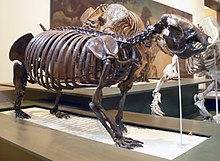Megalocnus
| Megalocnus Temporal range: Late Pleistocene to Holocene
| |
|---|---|

| |
| Mounted skeleton of M. rodens, AMNH, New York City | |
| Scientific classification | |
| Kingdom: | Animalia |
| Phylum: | Chordata |
| Class: | Mammalia |
| Order: | Pilosa |
| Family: | †Megalocnidae |
| Genus: | †Megalocnus Leidy, 1868 |
| Type species | |
| Megalocnus zile Leidy, 1868
| |
| Species | |
| |
Megalocnus ("great sloth" in Greek) is a genus of extinct giant ground sloths that were found on Cuba and Hispaniola. They were among the largest of the Caribbean ground sloths, with individuals estimated to have weighed up to 90 kg (200 lb) when alive. Two species have been described, M. rodens of Cuba, and M. zile of Hispaniola. Their relatives include other Caribbean ground sloths, such as Acratocnus, , Miocnus, Neocnus, Parocnus, and .[1] M. zile is currently thought to be a junior synonym of Parocnus serus.[2]
Fossil history[]
Subfossils of M. rodens indicate survival well into the Holocene. The most recent AMS radiocarbon date reported is 4190 BP, calibrated to c. 4700 BP.[3] This is similar to the most recent date reported for a Hispaniolan sloth, 4391 BP, calibrated to c. 5000 BP, for the small and probably semiarboreal Neocnus comes,[4] and some 1,200 years after the earliest known date for human occupation of Cuba, 5140 BP, calibrated to c. 5900 BP.[3]
Gallery[]

M. rodens at Cuban Academy of Sciences, Havana, early 1900s

M. rodens at Cuban Museum of Natural History, 2018

Partial M. rodens skull

Partial view of AMNH mount in left foreground
See also[]
References[]
- ^ Presslee, S.; Slater, G. J.; Pujos, F.; Forasiepi, A. M.; Fischer, R.; Molloy, K.; Mackie, M.; Olsen, J. V.; Kramarz, A.; Taglioretti, M.; Scaglia, F.; Lezcano, M.; Lanata, J. L.; Southon, J.; Feranec, R.; Bloch, J.; Hajduk, A.; Martin, F. M.; Gismondi, R. S.; Reguero, M.; de Muizon, C.; Greenwood, A.; Chait, B. T.; Penkman, K.; Collins, M.; MacPhee, R.D.E. (2019). "Palaeoproteomics resolves sloth relationships" (PDF). Nature Ecology & Evolution. 3 (7): 1121–1130. doi:10.1038/s41559-019-0909-z. PMID 31171860. S2CID 174813630.
- ^ McAfee, Robert K.; Beery, Sophia M. (2019-06-04). "Intraspecific variation of Megalonychid sloths from Hispaniola and the taxonomic implications". Historical Biology. 33 (3): 371–386. doi:10.1080/08912963.2019.1618294. ISSN 0891-2963. S2CID 195403443.
- ^ a b MacPhee, R. D. E.; Iturralde-Vinent, M. A.; Vázquez, O. J. (June 2007). "Prehistoric Sloth Extinctions in Cuba: Implications of a New "Last" Appearance Date" (PDF). Caribbean Journal of Science. College of Arts and Sciences, University of Puerto Rico. 43 (1): 94–98. doi:10.18475/cjos.v43i1.a9. S2CID 56003217. Retrieved 2009-05-11.
- ^ Steadman, D. W.; Martin, P. S.; MacPhee, R. D. E.; Jull, A. J. T.; McDonald, H. G.; Woods, C. A.; Iturralde-Vinent, M.; Hodgins, G. W. L. (2005-08-16). "Asynchronous extinction of late Quaternary sloths on continents and islands". Proc. Natl. Acad. Sci. USA. National Academy of Sciences. 102 (33): 11763–11768. Bibcode:2005PNAS..10211763S. doi:10.1073/pnas.0502777102. PMC 1187974. PMID 16085711.
External links[]
 Media related to Megalocnus at Wikimedia Commons
Media related to Megalocnus at Wikimedia Commons Data related to Megalocnus at Wikispecies
Data related to Megalocnus at Wikispecies
- Prehistoric sloths
- Prehistoric placental genera
- Pleistocene xenarthrans
- Pleistocene first appearances
- Holocene extinctions
- Pleistocene mammals of North America
- Extinct animals of Cuba
- Mammals of Hispaniola
- Extinct animals of the Dominican Republic
- Extinct animals of Haiti
- Fossils of Cuba
- Mammals of Cuba
- Mammals of the Caribbean
- Mammals of the Dominican Republic
- Mammals of Haiti
- Fossil taxa described in 1868
- Taxa named by Joseph Leidy
- Prehistoric mammal stubs





